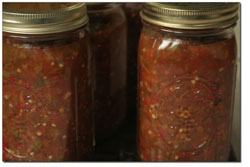|
| ||
| Nightshade sauce
by Ari LeVaux When harvest season arrives, I hit the farmers market like a sailor hits a strip club: with a fistful of dollars I never want to see again. And while I enjoy spending those dollars, I also bring the fun home with me, where it can last for months. Sometimes I’m on a mission, like this week, when I’m dead-set on amassing a year’s worth of salsa. By “year’s worth of salsa,” I mean about 20 quarts, or two batches in my 3-gallon pot. That’s just for me, a normal guy who takes his salsa in hearty but reasonable doses on his eggs and corn chips. Some people, like my friend Shorty, can sit down with a jar of salsa and a spoon and those 20 quarts will be gone before you can say “Buenos Nachos.” Because of Shorty, I actually try to put up several years’ worth of salsa each year. The active ingredients in salsa are tomatoes and peppers, both of which hail from a family of crops called nightshades, which also include eggplants and potatoes. This week I hit the market ready to fork over the equivalent of a fancy night on the town, about $100, for the makings of my yearly stash of spicy . Your quantity of tomatoes and peppers determines your onion, carrot and garlic requirements. These nightshades also constitute the bulk of your cash output, so they should be the focus of your deal-seeking efforts. The ratio of tomato to pepper should be about one-to-one in terms of volume, or three parts tomato to one part pepper by weight. For 40 pounds of tomatoes, you’ll want 10 large onions, 3 pounds of carrots, and six heads of garlic. Any tomato will do, but juicy, high-acid canning tomatoes are ideal. Your choice of peppers should be tailored to your heat tolerance and embrace diversity, representing as many shapes, colors, sizes and flavors as possible. Being on a salsa mission makes you a big spender at market. The farmers give you extra time-of-day, sweetening the pot with goodies like ears of corn, glasses of cider, or bulk deals. Oftentimes, toward the end of a market, you can help a farmer out by taking on an unsold box of tomatoes so ripe it needs to be used that afternoon. I learned the ways of from Roy, a friend, used-car dealer and Willie Nelson lookalike. Over the years, I’ve wandered from Roy’s path, as most grasshoppers do when they leave the monastery, nixing cumin and tomatillos from the recipe, for example. Nonetheless, Roy’s process lives on in my jars. Roy’s basic unit of measurement is the food processor load. Then, keep adding loads of peppers and tomatoes until the pot is full. Most of the work in making Roy-style salsa is prepping the veggies for maximum efficiency in the food processor. Onions are chopped, carrots and peppers are sliced into rounds, tomatoes are cut in half. Last time we made salsa, Roy’s food processor’s on/off switch was stuck in the “on” position, so he controlled it by clicking the lid in and out of place. Hunching over his machine, Roy worked his method with the fluidity of a truck driver finessing the gears of a 16-speed rig. The more diverse your selection of peppers, the more complex the finished product will be. Ye of little heat tolerance can assemble a posse of mild, sweet and medium varieties. Roy is a heavyweight, his tolerance forged in the days when salsa helped him quit drugs. Indeed, capsicum, the chemical behind the heat, is known to trigger an endorphin rush similar to runner’s high or heroine’s kick, that for Roy evidently acted like a gourmand’s methadone. Today, Roy uses jalapeños, bells, Anaheims, wax, big chiles, little chiles, cups of crushed dried chili peppers, crumbled handfuls of dried whole chili peppers, including a few habañeros, and for good measure, a can of Mexican-style pickled carrots and peppers, all run through the processor. When you make salsa with Roy, you need to wear rubber gloves, and wash your hands before – not just after – using the bathroom. Like Roy, I like my salsa extra-extra-hot. The flavors behind the heat are extraordinary. Plus, I get off on the endorphins. Most importantly, it slows down Shorty, who would otherwise mainline my stash. When the pot is nearly full, mix the contents, turn on the heat, and bring it to a boil, stirring and scraping often to prevent scalding. While heating, add a bunch of chopped cilantro, a cup of minced garlic, and salt and pepper to taste. Turn off the heat, ladle the salsa into hot sterilized jars, and screw on the sterilized rings and lids. The jars will seal as they cool. Soon you’ll gaze upon your new stash of salsa while you listen to a symphony of pings as the jars seal. Consider all the future meals your salsa will improve. Reflect on the good time that began at market earlier that day with nothing but a wad of cash, and turned into a good time that will keep on giving all year long. •
|
In this week's issue...
- May 15, 2025
- End of the trail
Despite tariff pause, Colorado bike company can’t hang on through supply chain chaos
- May 8, 2025
- Shared pain
Dismal trend highlights need to cut usage in Upper Basin, too
- April 24, 2025
- A tale of two bills
Nuclear gets all the hype, but optimizing infrastructure will have bigger impact


